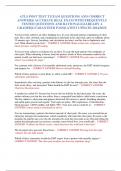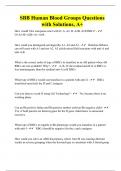ATLS POST TEST T EXAM QUESTIONS AND CORRECT
ANSWERS| ACCURATE REAL EXAM WITH FREQUENTLY
TESTED QUESTIONS AND RATIONALE|ALREADY A
GRADED|GUARANTEED PASS|LATEST UPDATE 2024/2025.
You have been called to an office building for a 47-year-old male patient complaining of chest
pain. He is alert, oriented, and complaining of mild pain in his chest that came on suddenly about
15 minutes ago. Airway, breathing, and circulation are intact, and his skin is diaphoretic and
cool. What should you do first? - CORRECT ANSWER Obtain a heart rate, respiratory rate,
blood pressure, and SpO2 reading
You have been called to a residence for an obese 52-year-old male patient who complains of
chest pain. When obtaining a history from the patient, which of these statements made by the
patient would you find most concerning? - CORRECT ANSWER The pain came on suddenly
when I was reading the paper."
For a patient with a history of an unstable abdominal aortic aneurysm, the EMT should recognize
and prepare for: - CORRECT ANSWER Massive internal bleeding
Which of these patients is most likely to suffer a silent MI? - CORRECT ANSWER A 55-year-
old female with diabetes
Immediately after assisting a patient with diabetes to take her nitroglycerin, she states that she
feels weak, dizzy, and nauseated. What should the EMT do next? - CORRECT ANSWER
Check her blood pressure
A mother has called 911 because her 6-year-old son told her he had chest pain. On scene, the
mother informs you that her son suffers from a congenital heart defect called aortic coarctation.
The boy admits to chest pain and appears distressed. His airway is patent, breathing adequate,
and radial pulse present and regular. Vital signs are pulse, 108; respirations, 24 breaths/min;
blood pressure, 148/92 mmHg; and SpO2, 98%. Your next action would be to: - CORRECT
ANSWER Contact medical command for advice
You are transporting a patient who had an episode of chest pain. On scene, you assisted him in
taking his nitroglycerin medication, which completely alleviated the chest pain. En route to the
hospital, the patient asks you why the nitroglycerin took the chest pain away. Beyond telling the
patient that nitroglycerin can increase coronary artery blood flow, you would add: - CORRECT
ANSWER "It dilates the blood vessels, which decreases the workload of the heart."
The tricuspid valve prevents blood from: - CORRECT ANSWER Flowing from the right
ventricle into the right atrium
Which of these statements would the EMT expect from a patient with unstable angina? -
CORRECT ANSWER "The chest pain awakens me from my nighttime sleep."
,A TV reporter has been assigned to your ambulance for a ride-along. He is doing a segment on
the local EMS system for EMS Week. In your down time, the reporter tells you that his wife was
diagnosed with atherosclerosis. He is unsure what this condition is and asks you to explain it to
him. Your response would be: - CORRECT ANSWER The coronary arteries become damaged
and narrowed by fat deposits.
You have arrived at a residence to help another crew with a 62-year-old woman who is
complaining of fatigue, chest discomfort, and diaphoresis. The EMTs on scene report that she
has a history of hypertension from atherosclerosis, for which she takes a blood pressure pill, and
is also prescribed nitroglycerin. She reports an allergy to aspirin. Vital signs are pulse, 64;
respirations, 16 breaths/min; blood pressure, 128/86 mmHg; and SpO2, 97% on room air. Which
of these statements made by your EMT partner would require immediate correction on your part?
- CORRECT ANSWER D.
"I am going to put the patient on high-concentration oxygen because she has chest discomfort."
When assessing a patient in the prehospital setting, which of these does the EMT recognize as an
indication for aspirin? - CORRECT ANSWER Chest discomfort that is suggestive of a heart
attack
All arteries: - CORRECT ANSWER Carry blood away from the heart
A patient with chest pain has an SpO2 of 90% on room air. How would you start providing
oxygen to this patient? - CORRECT ANSWER Nasal cannula 2 lpm
A patient with chest pain and shortness of breath informs you that the last time he had a heart
attack, he went into heart failure. When performing your secondary assessment, which sign or
symptom is most indicative that the patient is in heart failure again? - CORRECT ANSWER
Crackles in the lungs
The EMT understands diastolic blood pressure when he defines it as: - CORRECT ANSWER
The pressure in the arteries between cardiac contractions."
A 44-year-old male patient is experiencing chest pain. He has a history of angina and is
prescribed nitroglycerin, which he has not taken yet. He is also taking another medication.
Which of these medications is a contraindication to the administration of nitroglycerin? -
CORRECT ANSWER Levitra
When administering aspirin to a patient with chest discomfort that is suggestive of a heart attack,
the EMT recognizes that this medication will benefit the patient by: - CORRECT ANSWER
Decreasing the ability of the platelets in the blood to form clots
An elderly patient with diabetes who experiences a silent MI will most likely: - CORRECT
ANSWER Not be awakened by a heart attack as he sleeps
A patient with a past medical history of angina is now complaining of chest discomfort. When
assessing this patient, which sign or symptom should alert the EMT that the patient is probably
,experiencing an acute myocardial infarction and not an anginal attack? - CORRECT ANSWER
Chest discomfort is not relieved by nitroglycerin
In the blood, which component is largely responsible for the formation of blood clots? -
CORRECT ANSWER Platelets
Dysfunction of the heart's electrical conduction cells from ischemia or infarction may cause -
CORRECT ANSWER Irregular heartbeats
You have been called for a patient with angina. On scene, the 67-year-old man reports that he
has a history of angina and the pain started when he was moving firewood from the garage into
his house. Unfortunately, the pain has yet to go away, despite three nitroglycerin tablets and 20
minutes of rest. Your next action should be to: - CORRECT ANSWER Check the patient's vital
signs
A paramedic administers a medication to decrease the effect of the parasympathetic nervous
system on the heart. In response to this treatment, the EMT would expect which vital sign
change? - CORRECT ANSWER Increase in heart rate
A 71-year-old male patient with a cardiac history and lower abdominal and back pain has called
911 for help. On scene, you detect a large pulsatile mass in his abdomen. With the exception of
skin that is diaphoretic, the primary assessment indicates no life threats to the airway, breathing,
or circulation. The patient has a history of hypertension, high cholesterol, and diabetes, and is
allergic to sulfa-based medications. Vital signs are pulse, 92/min; respirations, 20 breaths/min;
blood pressure, 130/66 mmHg; and SpO2, 95% on room air. Which of these statements made by
the patient would make you intervene immediately? - CORRECT ANSWER "I am going to take
my daily aspirin since I did not take it this morning."
After being dispatched for a male patient experiencing dyspnea, you arrive to find the confused
67-year-old man sitting upright at his kitchen table in severe respiratory distress. You also note
remarkable swelling to his lower legs and feet. He has an open airway, but cannot speak more
than two to three words without attempting to breathe. His breathing is extremely labored, with
inspiratory crackles heard upon auscultation. His skin is cool, diaphoretic, and dusky in color. A
family member at the scene reports a history of hypertension, congestive heart failure, and
angina, for which the patient takes nitroglycerin. The baseline vital signs are acceptable and the
room-air pulse oximeter reading is 45%. What is your immediate action in caring for this
patient? - CORRECT ANSWER Apply continuous positive airway pressure (CPAP)
A patient complaining of shortness of breath and dizziness has called 911. Her history includes
chronic obstructive pulmonary disease (COPD). When assessing the patient, which of these
findings would cause you to immediately prepare the patient for transport? - CORRECT
ANSWER Pulsating mass in the abdomen
You are completing the prehospital care report and are documenting the fact that you assisted a
patient in taking his nitroglycerin pill. How will you document the route of administration? -
CORRECT ANSWER Sublingual
, A patient has been diagnosed with high blood pressure. A medication that can effectively serve
to lower this patient's blood pressure is one that: - CORRECT ANSWER Dilates the arteries
To save additional heart muscle from dying when a patient suffers an acute myocardial infarction
(heart attack), which treatment must occur? - CORRECT ANSWER Relieving the obstruction in
the coronary arteries
A patient has pulmonary hypertension, which has increased the resistance in the pulmonary
blood vessels. In response, what will most likely occur over a long period of time? - CORRECT
ANSWER The right side of the heart will weaken
When obtaining a medical history, which of these statements made by the patient seemingly
indicates that he is suffering from classic angina? - CORRECT ANSWER When I stopped
cutting the grass, the pain went away."
When treating a patient with chest discomfort, the EMT's primary goal is to - CORRECT
ANSWER Recognize the possibility of cardiac compromise and provide proper emergency care
You are treating a 67-year-old male patient with chest pain and a history of prior heart attacks as
well as diabetes and hypertension. The patient has taken three nitroglycerin tablets, which have
decreased his pain from 7/10 to 4/10; however, the pain persists. Initially, his SpO2 was 91% on
room air. Oxygen was applied by nasal cannula and now, on 3 lpm O2, his SpO2 is 97%. How
would you address the oxygen administration, given that the patient still has chest pain? -
CORRECT ANSWER Decrease the oxygen flow to 2 lpm
A patient complains of chest pain that radiates into his neck and arms. The primary assessment
reveals a patent airway, adequate breathing, and a strong, regular radial pulse. The patient's skin
is warm and dry, and reveals no signs of inadequate perfusion. What should you do next? -
CORRECT ANSWER Check vital signs
You are treating a patient for mild chest pain but notice that his blood pressure is elevated.
Which of these statements made by the patient would make you suspect he has acute
hypertension? - CORRECT ANSWER The doctor checks my blood pressure regularly and it's
not normally that high."
Which of these statements made by the patient should the EMT associate with the condition of
congestive heart failure? - CORRECT ANSWER "I have a hard time breathing when I am lying
down."
A patient informs you that he has a history of an abdominal aortic aneurysm. To best assess the
status of this condition, you should: - CORRECT ANSWER Assess the abdomen
You have just arrived by the side of a male patient who is in cardiac arrest. Emergency Medical
Responders have been on scene for 6 minutes performing CPR. Advanced life support (ALS) has





